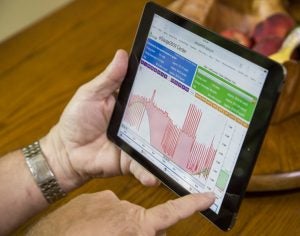 By Kim Sha and Ben Liu, clean energy interns
By Kim Sha and Ben Liu, clean energy interns
Illinois’ largest utility, ComEd, is almost finished deploying advanced metering infrastructure to its customers. In fact, there are now more than 3.8 million installed smart meters in Illinois, feeding anonymized energy-use data – recorded in half-hourly kilowatt-hours – back from the grid.
How to make use of this unwieldy flood of data and enhance the efficiency of the grid? Our new paper, Modelling Marginal System Costs for the Commonwealth Edison Distribution Network, provides a framework for regulators, utilities and other researchers to begin to examine the insights provided by smart meter data, highlighting opportunities to save money for customers and utilities alike. Specifically, our study shows that under real-time electricity pricing, ComEd customers can save money not only by changing how much electricity they use, but by adjusting when they use it.
Building on existing research
Real-time pricing charges people different electricity rates depending on the time of day, and it has been shown before that ComEd customers save money by switching to real-time pricing.
Last year, Environmental Defense Fund (EDF) and Illinois’ utility watchdog, Citizens Utility Board (CUB), came together to conduct one of the first analyses of anonymized energy-use data provided by ComEd. This early foray revealed that real-time electricity pricing would have helped nearly all ComEd customers save money in 2016, based on a study of over 300,000 homes.
Our new paper takes that analysis a step further.
With dynamic electricity pricing, more data can lead to more savings Share on XNew results
For the purposes of this study, we developed a custom real-time pricing scheme to reflect how electricity should have been priced if the utility had perfect knowledge of historical system costs – i.e. looking back on actual data rather than relying on forecasts of energy demand. We then applied this pricing scheme, which is very close to ComEd’s Residential Real-Time Pricing, to ‘typical’ customers’ energy-use patterns.
The giant pool of customer data was divided into several layers by year, season and day of the week. These subsets were further characterized using a statistical clustering algorithm.
The study found that, given the same energy-use behavior, most residential customers on flat-rate billing would benefit – or save money – from moving to a real-time pricing scheme. Single households that switch to a real-time pricing scheme can save up to 30 percent on their electricity bills in comparison to flat-rate billing.
Although consuming less energy undoubtedly saves money, doing so when real-time prices are cheaper is also a large determinant of electricity bills. This doesn’t necessarily mean you have to constantly check and adjust how much electricity you’re using. Although ‘flattening’ energy use – i.e. trying to make power demand consistent throughout the day – has traditionally been seen as an important factor in reducing costs, our results show that the same could be achieved just by shifting the time your ‘peak’ usage occurs.
For example, instead of running your dishwasher around 7 pm when many people are home, awake and using appliances, you could save more money by running it a few hours later – during ‘off-peak’ hours. The potential for savings is most observable in the summer months because of high AC demands during the early evening hours.
Moreover, shifting to a real-time pricing scheme will reduce overall system costs for the utility by optimizing the efficiency of the distribution network. A more efficient network means less waste, which is cheaper for everyone.
Tip of the iceberg
The data-analysis collaboration between EDF and CUB is yielding more precise findings than ever before. We hope ours will not be a singular, isolated effort. Utilities must educate customers. Policy makers should encourage sustainable living. Researchers must continue to tackle tomorrow’s energy challenges.
Dynamic electricity pricing is a step in the right direction, but how can we prepare the electricity grid for a future powered by renewable energy, or a future replete with electric vehicles? The continuous characterization of our power network is necessary for the realization of a cleaner and more efficient grid infrastructure. Energy data will be key to solving the puzzle – and we’re just getting started.









